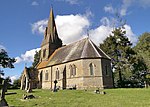Wolferlow
Herefordshire geography stubsVillages in Herefordshire

Wolferlow is a village and civil parish in northern Herefordshire, England, about 4 miles (6.4 kilometres) north of Bromyard. In the fourteenth century the manor of Wolfelow belonged to the Earl of March; about 1310 it was granted to Walter de Thornbury, a retainer of the Earl, who became Lord Chancellor of Ireland. Thornbury died in a shipwreck in 1313 while attempting to secure confirmation of his election as Archbishop of Dublin.
Excerpt from the Wikipedia article Wolferlow (License: CC BY-SA 3.0, Authors, Images).Wolferlow
High Lane,
Geographical coordinates (GPS) Address Nearby Places Show on map
Geographical coordinates (GPS)
| Latitude | Longitude |
|---|---|
| N 52.2526 ° | E -2.4867 ° |
Address
High Lane
HR7 4PZ
England, United Kingdom
Open on Google Maps








